Last week I began a series of posts showing you how to date your old family photographs using format and process, by looking at daguerreotypes, the very first commercial photographic process.
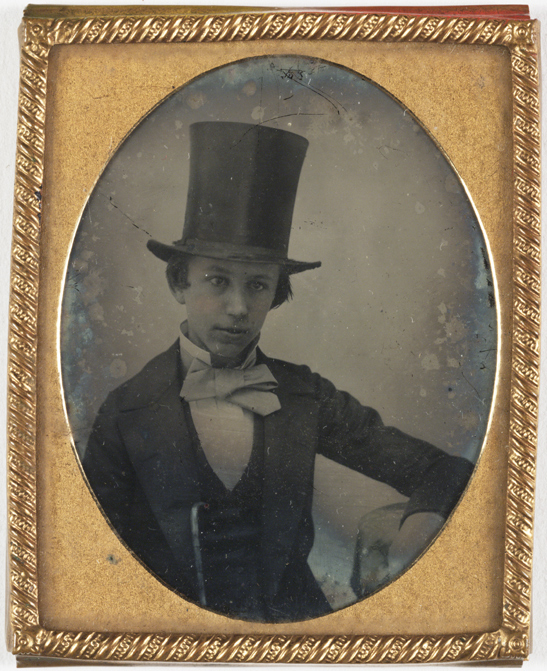
This week I’m going to show you how to identify a collodion positive—also known as an ambrotype—using just a few simple clues, then we’ll take a look at some examples of collodion positives in our collection.
About the collodion positive process
The collodion positive, or ambrotype, first appeared in about 1853. By the 1860s the process had largely disappeared from high street studios, but it remained popular with itinerant open-air photographers until the 1880s, because portraits could be made in a few minutes while sitters waited.
The collodion positive process, which was based on the collodion negative process invented by Frederick Scott Archer, reversed a negative image by bleaching the silver salts. The dark areas which would normally form the highlights in a printed image turned pale, and the clear areas which would form the shadows in the print appeared to be dark.
When presented against a black background, the dark areas of the original negative, which had been bleached with nitric acid or bichloride of mercury, appeared as highlights. The black backing, visible through the clear areas of the plate that originally formed the highlights, appeared as shadows.
Although the so-called collodion positive was in fact a negative, the emulsions were too thin to make satisfactory prints on paper. When a collodion positive was held to the light without the backing material, the image still looked like a negative, though paler than the standard required to make a satisfactory positive print.
The dark backing material could be a velvet pad held inside a presentation case, or a simple coating of black varnish for those made in lower-class studios and temporary booths erected at holiday resorts.
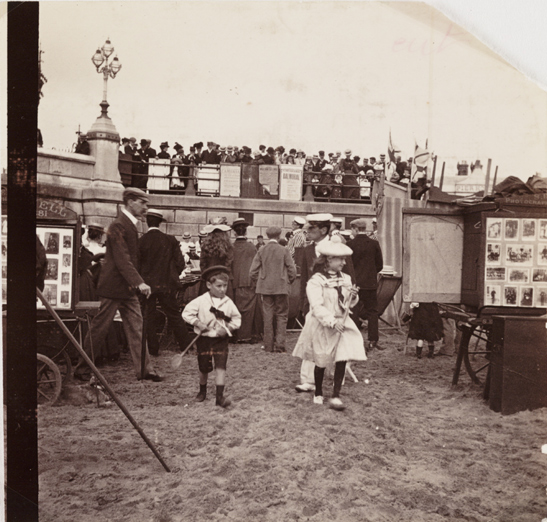
One slight drawback with this process was that the image was reversed laterally, like the reflection you see in a mirror.
To correct this, the plate could be blackened on the collodion side or presented in the case emulsion-side down, which had the added benefit of protecting the vulnerable collodion layer. Otherwise, the surface of the finished plate was coated with clear varnish and it was protected under a ‘cover-glass’.
Why is the collodion positive also known as an ‘ambrotype’?
Most people call collodion positives ‘ambrotypes’, which is technically incorrect.
The ambrotype process (patented by American photographer James Ambrose Cutting in 1854) was a particular variant of the process which used Canada balsam to seal the collodion plate to the cover glass. These are most commonly found in America.
Use these clues to identify a collodion positive
Case
Collodion positives are often confused with daguerreotypes because they are a similar size and were also usually supplied in a protective case or frame.
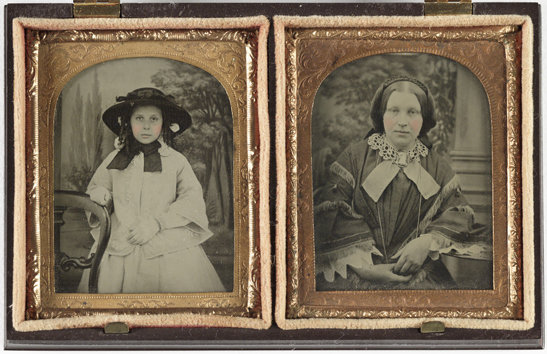
Glass negative
They were made by taking a glass negative and backing it with black cloth, paint, or varnish to produce a positive image.
Image
Unlike daguerreotypes, collodion positives always appear as a positive image, whatever angle you view them.
Quality
Collodion positives were much cheaper than daguerreotypes. The quality of the materials used to make their cases usually reflects this—compressed paper and card rather than leather and silk.
Examples of collodion positives in our collection
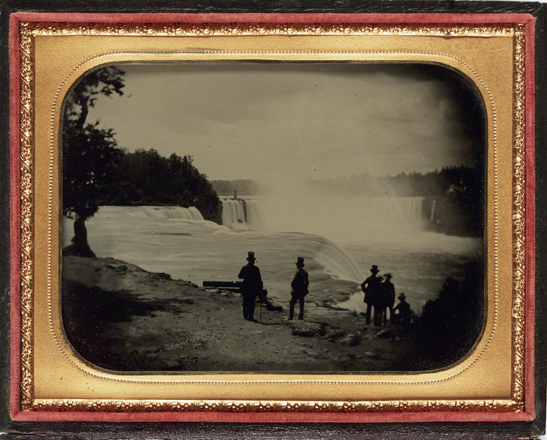
Platt D. Babbitt set up a pavilion in front of Point View, later Prospect Point, on the American side of Niagara Falls. From here he photographed tourists taking in the view, without their knowledge, from the 1850s to the 1870s. He would then offer the photographs for sale, providing a lucrative business for himself and giving tourists a chance to own a souvenir of their trip.
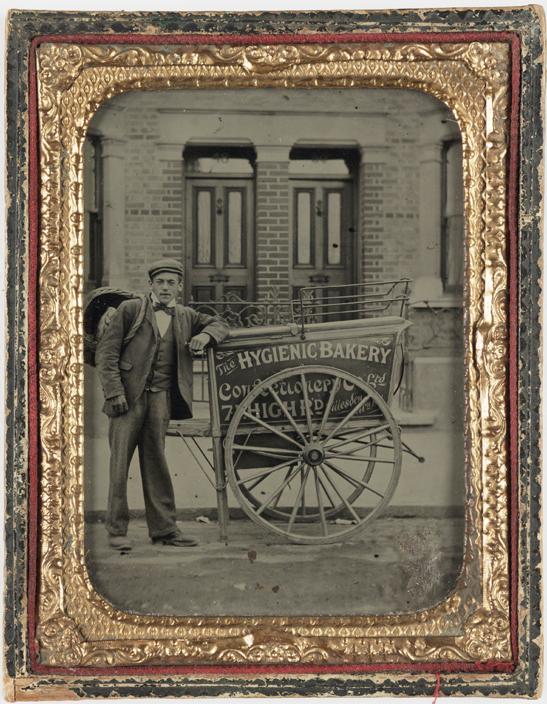
The sign on the cart reads: ‘Hygienic Bakery, Confectioners Co. Ltd. 7 High Rd., Willesden’. The photograph is mounted in an inexpensive papier-mâché case which was designed to hang on a wall. The subject matter, the ready-made metal mount and style of case suggest that image was taken by an itinerant or non-studio-based photographer.
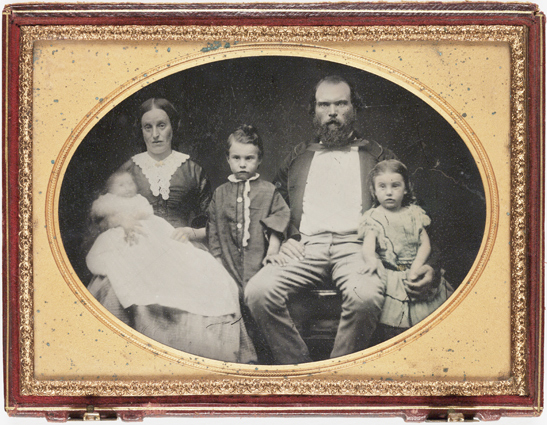
The entire family appear to be rather bewildered by the process of having their photograph taken. All retain their pose, with the exception of the baby on her mother’s lap who has moved and becomes a blurry, ghost-like figure.
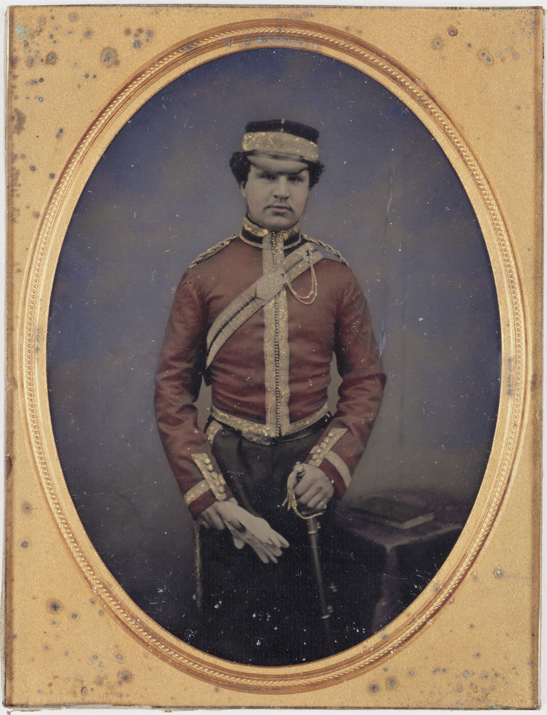
This British cavalry soldier is wearing a short, tight-fitting shell jacket and cap, carrying his sword and gloves in his hands. He had probably served in the British army during the Crimean War (1854–1856). This photograph has been hand-coloured to give a realistic colour to the officer’s uniform and to pick out the gold embroidery, sash and ring that he wears. Having an ambrotype hand-coloured cost extra.
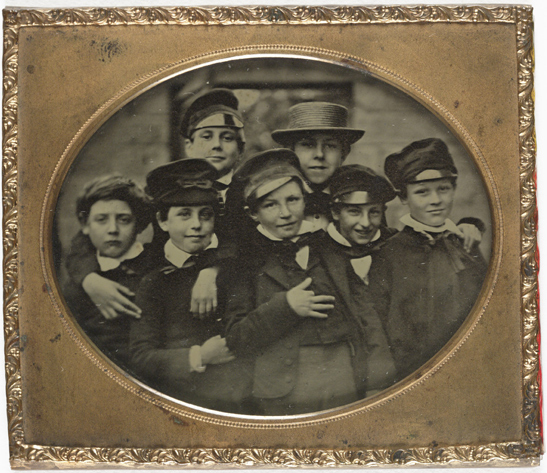
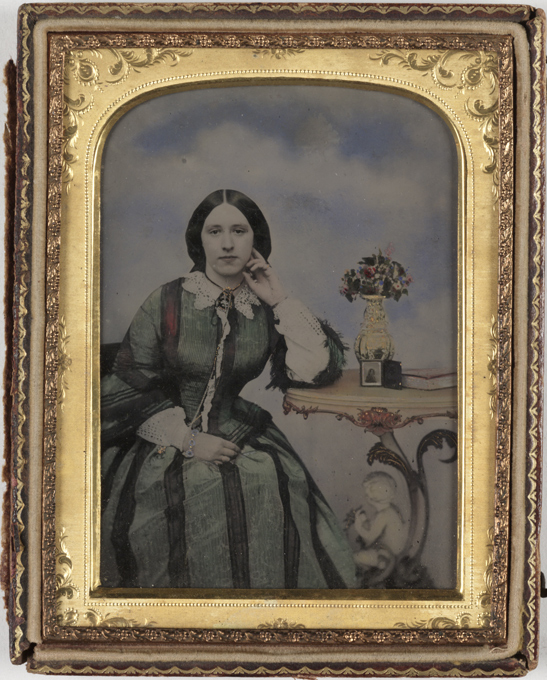
The woman rests her elbow on a table, her arm next to an elegant vase of flowers and a cased photograph. The photograph on the table appears to be either an ambrotype or a daguerreotype. It may have been included to represent someone who had recently died.
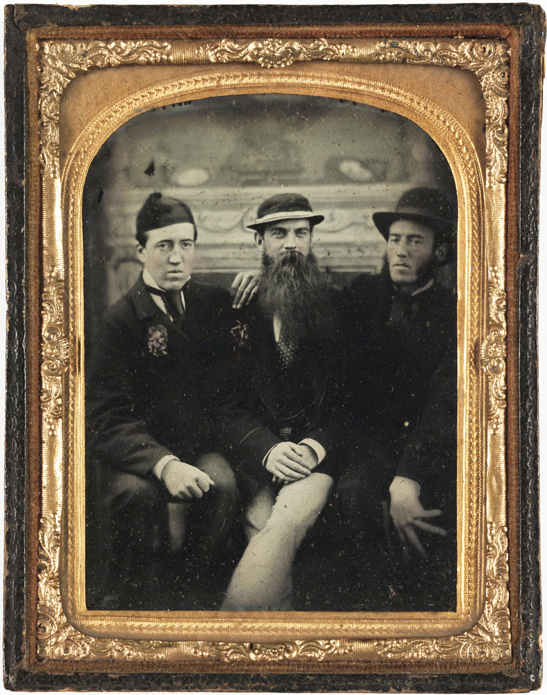
These smartly-dressed, serious looking men are pictured in front of a painted background of a grand fireplace. They are all in suits and have flowers in their buttonholes, perhaps indicating this was taken on a special occasion.
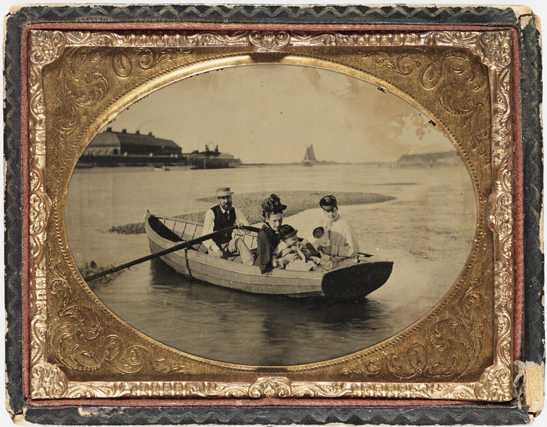
More in the series
- How to spot a daguerreotype (1840s–1850s)
- How to spot a ferrotype/tintype (1855–1940s)
- How to spot a carte de visite (late 1850s–c.1910)
- How to spot a cabinet card (1866–c.1914)
- How to spot a postcard (1900–1950s)
- How to date Victorian photographs
- How to date photographs by fashion
- Researching your photographer ancestors
A most helpful introduction to the subject Colin. Thanks.
Here is a further selection you might enjoy:
http://www.luminous-lint.com/app/vexhibit/_PROCESS_Ambrotype_01/5/0/0/
I have a set of early photographs of Niagara Falls, taken probably in the mid to late 1800s. They are half plate and are positives on glass. It seems that two sheets of glass are sandwiched together and the image is therefore protected. These are positive images, not negative, and are transparent. I have been unable to find anything out about this type of photograph. Could these be a form of ambrotype, perhaps made by using the original as a negative and making a contact print onto another sheet of glass?
I also have a transparent photo like that, did you ever get a response? I cant find anything on the internet..just curious, its see through.
Hi Anna,
I was wondering if you ever got a response on your transparent photo from a couple years ago? I just acquired some and cannot find out anything about them on the internet, so I thought I’d try to reach you and see if you ever found any info on them. Thank you! ~Lisa
Hi Heidi,
I doubt that you will get this since it has been 7 years since you asked your question about the Niagra Falls positives on glass, but I was wondering if you ever found out what they were? I just acquired 48 positives on glass that are also 2 pieces of glass sandwiched together and some of them have parts that are hand tinted with a gel looking substance. Most of them are of old etchings and paintings. I can’t find anything on the internet about them, so I thought it was worth a shot to reach out to you. Thank you, ~Lisa
I have a large collection of photographs on glass and am not sure exactly what they are and do not know of anywhere I could take them for assessment – I am in SW Scotland if you know of anywhere that might be willing to have a look and provide further information I would greatly apprectiate it.
I have some pieces of the building by the Milken brothers new york in 1910 during the Porfiriato in the city of mexico what could be the greatest work of latinoamerica these collodion negatives could help me figure out the price and if someone interested in these beautiful pictures collection thanks
I have just discovered three copper plates with images of people, presumably relatives, impregnated onto the copper. You have to tilt the plates in a particular direction to view the images, and these were almost sent for metal recycling. I would love to know if they were photograph plates but am not sure where to start enquiring.
What you have there is a Daguerreotype – and early processes invented in 1839 by Louis Daguerre. The impression is made onto a polished silver surface that was electroplated onto a piece of copper, sensitized and developed in mercury vapour.
I also have one of a 1800 young lady and must angle it to see it. It is 5×7 and there was a big safety pin about four inches long and I think it was she had. The plate is copper. I don’t see any information on here so I thought I would describe mine. I bought it at an auction at least 30 years ago in a box of other things.
Hi there – I’m not sure if you still use this thread but I thought it was worth a shot. I have recently discovered (what appears to be) an Ambrotype photograph whilst looking through old photos from my Grandfather. Would you be able to help identify if this is, in fact, an Ambrotype and if it is a British or American photo? The clothing the woman is wearing bears a real resemblance to the American attire of that period, although I have got that wrong.
Many thanks,
Lizzy
Thank you, this is the first time I have heard about ambrotypes! I have a picture of my grandmother on curved glass. I found it without a frame, so I had one custom-made to protect it. She was born in Scotland in 1869, married in 1893. Is it likely an ambrotype since both dates are late on the timeline?
I have alot of tintypes from the 1800’s. Was wondering did photographer’s after taking photo reversed the negative when developing photo on paper or metal? I noticed some males have buttons on left side of clothing and some are on the right. Was told as a kid by my grandma back in the 1970’s that male clothing has the button on the right side of clothing always and female is on the left side. Why I was curious to know if photographers reversed the negative when they developed photo. Would explain why some photos have the buttons for males on left sometimes and right same as females. Ring position of married couples too. Thanks
Hope to get more information on the copper daguerreotype I have had thirty years plus.
Hoping to get information on the daguerreotype copper plate 5×7 a young woman in 1800’s fashion. I could never sell it because it is difficult to produce picture, you have to turn it a certain way to see the picture.
I used to be an avid antique collector. I had a shop at our Trading Post in Wheeler County, Oregon. I collected quite a few at auctions and garage sales. I want to sale some as I am getting older and the prices seem to be going down, which to me is so sad. I have no idea how much the daguerreotypes have any interest but I do watch Antique Roadshow and see all the antiques that have lost their value. I would love to get information. I have a very large store weighing machine with the marble plate that you put things on to weigh and it is a good three feet high and very large across, it weighs at least 25 lbs. Our store was a stage stop where they switched horses in the barn which is falling apart.
Hi-did you ever get any responses? Sounds like a great scale. Do you want to sell? Thx,
Ellen
I need info on what I think is an Ambro ..but parts have been cut away and replaced with fabric it appears in gown and hair area…I have never seen this before …any help would be deeply appreciated !
I have what I believe is a Ambro that has pic cut away replaced with fabric..have never seen before and am looking for similar or advice.
Thank you…Joanie
I have 4 old framed photos would like to try to find a collector it’s of Joseph Haynesworth Earle and Annie Wilton Earle …And Gen Geo Washington Earle and Elizabeth Robinson Earle from the 1700 an 1800’s